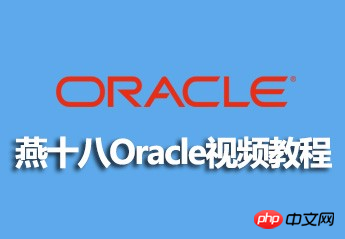
The relational database products developed by Oracle are famous for their excellent performance. Oracle database products are used by the top 1,000 companies on the fortune list. Many large websites also choose Oracle systems, which are the best database products in the world. "Yan Shiba Oracle Video Tutorial" explains the basic knowledge about Oracle, including the purpose of learning Oracle, basic add, delete, modify and query statements. Just like learning MySQL, it explains all common knowledge points about Oracle.

Course playback address: http://www.php.cn/course/430.html
This video was created by Yan Shiba. The teacher’s teaching style is:
The teacher’s lectures are vivid, witty, witty, and touching. A vivid metaphor is like the finishing touch, opening the door to wisdom for students; a well-placed humor brings a knowing smile to students, like drinking a glass of mellow wine, giving people aftertaste and nostalgia; a philosopher's aphorisms, cultural references Proverbs are interspersed from time to time in the narration, giving people thinking and alertness.
The more difficult point in this video is the recursive function in the Oracle advanced course:
To put it simply, it is to convert a tree The structure is stored in a table. For example, there are two fields in a table:
org_id, parent_id. Then by indicating who the parent of each record is, a tree structure can be formed.
Use the above syntax query to obtain all records of this tree.
Where:
Condition 1 is the qualifying statement of the root node. Of course, the qualifying conditions can be relaxed to obtain multiple root nodes, which is actually multiple trees.
Condition 2 is the connection condition, in which PRIOR is used to represent the previous record. For example, CONNECT BY PRIOR org_id = parent_id means that the org_id of the previous record is the parent_id of this record, that is, the father of this record is the previous record.
Condition 3 is a filtering condition, used to filter all returned records.
A brief introduction is as follows:
When scanning a tree structure table, you need to access each node of the tree structure accordingly. A node can only be accessed once. The access steps are as follows:
The first step : Starting from the root node;
Step 2: Visit the node;
Step 3: Determine whether the node has unvisited child nodes. If so, turn to the leftmost unvisited child node. subsection, and execute the second step, otherwise execute the fourth step;
Step 4: If the node is the root node, the access is completed, otherwise execute the fifth step;
Step 5: Return to the node the parent node and perform the third step.
In short: the process of scanning the entire tree structure is also the process of in-order traversal of the tree.
#Here we also recommend source code resources for everyone Download: http://www.php.cn/xiazai/learn/1844
This video courseware is shared with everyone:
1.19 Learn by example plsql.txt2.Installation process under Linux.txt3.oracle.ppt4.oracle database.doc5. oracle download and install.txt6.oralce-install-linux.pdf7. Trigger example.txtThe above is the detailed content of Yanshiba Oracle video resources (source code courseware) sharing. For more information, please follow other related articles on the PHP Chinese website!




